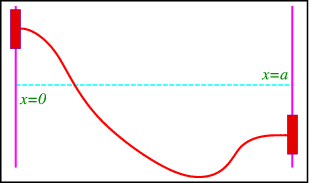
It is not always possible on separation of variables to separate initial or boundary conditions in a condition on one of the two functions. We can either map the problem into simpler ones by using superposition of boundary conditions, a way discussed below, or we can carry around additional integration constants.

Let me give an example of these procedures. Consider a vibrating string attached to two air bearings, gliding along rods 4m apart. You are asked to find the displacement for all times, if the initial displacement, i.e. at t = 0s is one meter and the initial velocity is x∕{t}_{0}\ m∕s.
The differential equation and its boundary conditions are easily written down,
Question: What happens if I add two solutions v and w of the differential equation that satisfy the same BC’s as above but different IC’s,
Answer: u=v + w, we can add the BC’s.
If we separate variables, u(x,t) = X(x)T(t), we find that we obtain easy boundary conditions for X(x),
|
X'(0) = X'(4) = 0,
| (5.42) |
but we have no such luck for (t). As before we solve the eigenvalue equation for X, and find solutions for {λ}_{n} = {{n}^{2}{π}^{2}\over 16} , n = 0,1,..., and {X}_{n} =\mathop{ cos}\nolimits ({nπ\over 4} x). Since we have no boundary conditions for T(t), we have to take the full solution,
and thus
Now impose the initial conditions
|
u(x,0) = 1 = {1\over
2}{A}_{0} +{ \mathop{∑
}}_{n=1}^{∞}{A}_{
n}\mathop{ cos}\nolimits {nπ\over
4} x,
| (5.45) |
which implies {A}_{0} = 2,
{A}_{n} = 0,n > 0.
|
{∂u\over
∂t} (x,0) = x∕{t}_{0} = {1\over
2}{B}_{0} +{ \mathop{∑
}}_{n=1}^{∞}{nπc\over
4} {B}_{n}\mathop{ cos}\nolimits {nπ\over
4} x.
| (5.46) |
This is the Fourier sine-series of x, which we have encountered before, and leads to the coefficients {B}_{0} = 4 and {B}_{n} = − {64\over { n}^{3}{π}^{3}c} if n is odd and zero otherwise.
So finally
|
u(x,t) = (1 + 2t) −{64\over {
π}^{3}}{ \mathop{∑
}}_{n\ odd} {1\over {
n}^{3}}\mathop{ sin}\nolimits {nπct\over
4} \mathop{cos}\nolimits {nπx\over
4} .
| (5.47) |